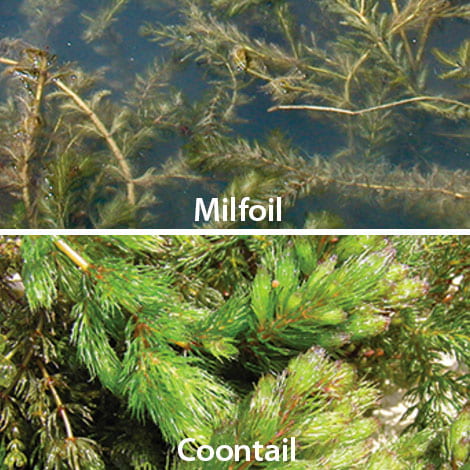Asked By: Paul, Greenfield, OH
A: Invasive aquatic plants like milfoil and coontail can cause trouble in your pond or lake. Though they provide food and shelter for birds, insects, fish and other pond critters, they can form dense colonies, reducing access to open water, limiting fishing access, and interfering with boating and swimming.
Milfoil and coontail look similar and – thankfully – can be treated with similar chemicals. Here's what you need to know about identifying and managing these nuisance plants.
Milfoil Identification
When you think
milfoil, think feather-like.
Many different species of milfoil and watermilfoil exist in North America. In general, milfoil is found in water that's less than 20 feet (6 meters) deep. In water less than 15 feet (4½ meters) deep, it can form dense mats over the surface. The plant is comprised of long stems with air canals and flat, feather-like, whorled leaves that are pinnately divided.
Milfoil is an important food source for waterfowl, but these nuisance plants can aggressively invade lakes, ponds and waterways. Once they're established, they're almost impossible to eradicate and so periodic maintenance is necessary to keep them under control.
Coontail Identification
When
coontail comes to mind, think of a Christmas tree.
Also known as hornwort, coontail also thrives in water less than 20 feet deep. The rootless invasive plant grows below the surface, and it has a central hollow stem and dark green leaves that are spiny, forked and bushy near the tip, giving it its "coontail" or Christmas tree appearance.
Like milfoil, coontail provides food for waterfowl and cover for young bluegills, perch, largemouth bass and northern pike, but it needs to be managed to prevent it from taking over your pond or lake.
Keeping Them Under Control
Many of the submerged weed chemicals available treat both milfoil and coontail. Depending on how you use your pond, the best choices are:
- Ultra PondWeed Defense: This liquid herbicide has short-term drinking (three days for human consumption; one day for animal consumption) and irrigation restrictions (five days).
- Fluridone (WipeOut): If your entire pond is infested, try WipeOut. It can kill the invaders down to their roots, but expect slower results (it can take up to 90 days for full protection) and longer irrigation restrictions (30 days). Note: WipeOut should only be used in ponds with little to no flow.
- KnockDown Defense: To use KnockDown, you'll need to spray the fast-acting herbicide with a tank sprayer – but you can start using the water again for irrigation in just five days.
Regardless which one you choose, the best time to apply it is when the weeds are actively growing.
Help From the Experts
If you can't figure out which aquatic weed is growing in your pond, pull one (or more!) from the pond,
snap a picture and email it, or email us a sample in a dry paper towel. We can help you identify the invader and suggest the best chemical to control it.

